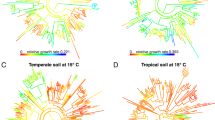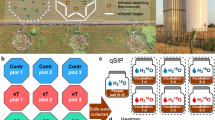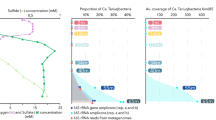Abstract
Antarctic ecosystems are fascinating in their limited trophic complexity, with decomposition and nutrient cycling functions being dominated by microbial activities. Not only are Antarctic habitats exposed to extreme environmental conditions, the Antarctic Peninsula is also experiencing unequalled effects of global warming. Owing to their uniqueness and the potential impact of global warming on these pristine systems, there is considerable interest in determining the structure and function of microbial communities in the Antarctic. We therefore utilized a recently designed 16S rRNA gene microarray, the PhyloChip, which targets 8741 bacterial and archaeal taxa, to interrogate microbial communities inhabiting densely vegetated and bare fell-field soils along a latitudinal gradient ranging from 51 °S (Falkland Islands) to 72 °S (Coal Nunatak). Results indicated a clear decrease in diversity with increasing latitude, with the two southernmost sites harboring the most distinct Bacterial and Archaeal communities. The microarray approach proved more sensitive in detecting the breadth of microbial diversity than polymerase chain reaction-based bacterial 16S rRNA gene libraries of modest size (∼190 clones per library). Furthermore, the relative signal intensities summed for phyla and families on the PhyloChip were significantly correlated with the relative occurrence of these taxa in clone libraries. PhyloChip data were also compared with functional gene microarray data obtained earlier, highlighting numerous significant relationships and providing evidence for a strong link between community composition and functional gene distribution in Antarctic soils. Integration of these PhyloChip data with other complementary methods provides an unprecedented understanding of the microbial diversity and community structure of terrestrial Antarctic habitats.
Similar content being viewed by others
Log in or create a free account to read this content
Gain free access to this article, as well as selected content from this journal and more on nature.com
or
References
Aislabie JM, Chhour K-L, Saul DJ, Miyauchi S, Ayton J, Paetzold RF et al. (2006). Dominant bacteria in soils of Marble Point and Wright Valley, Victoria Land, Antarctica. Soil Biol Biochem 38: 3041–3056.
Bokhorst S, Huiskes AHL, Convey P, Aerts R . (2007a). Climate change effects on organic matter decomposition rates in ecosystems from the Maritime Antarctic and Falkland Islands. Glob Change Biol 13: 2642–2653.
Bokhorst S, Huiskes AHL, Convey P, Aerts R . (2007b). The effect of environmental change on vascular plant and cryptogam communities from the Falkland Islands and the Maritime Antarctic. BMC Ecol 7: 15.
Bokhorst S, Huiskes AHL, Convey P, van Bodegom PM, Aerts R . (2008). Climate change effects on soil arthropod communities from the Falkland Islands and the Maritime Antarctic. Soil Biol Biochem 40: 1547–1556.
Brinkmann M, Pearce DA, Convey P, Ott S . (2007). The cyanobacterial community of polygon soils at an inland Antarctic nunatak. Polar Biol 30: 1505–1511.
Brodie EL, DeSantis TZ, Joyner DC, Baek SM, Larsen JT, Andersen GL et al. (2006). Application of a high-density oligonucleotide microarray approach to study bacterial population dynamics during uranium reduction and reoxidation. Appl Environ Microbiol 72: 6288–6298.
Brodie EL, DeSantis TZ, Parker JPM, Zubietta IX, Piceno YM, Andersen GL . (2007). Urban aerosols harbor diverse and dynamic bacterial populations. Proc Natl Acad Sci USA 104: 299–304.
Casgrain P, Legendre P . (2001). The R Package for Multivariate and Spatial Analysis. Département de sciences biologiques, Université de Montréal: Montréal, Canada.
Cole J, Chai B, Farris R, Wang Q, Kulam S, McGarrell D et al. (2005). The Ribosomal Database Project (RDP-II): sequences and tools for high-throughput rRNA analysis. Nucleic Acids Res 33: D294–D296.
Convey P . (2001). Antarctic ecosystems. In: Levin SA (ed). Encyclopedia of Biodiversity. Academic Press: San Diego, CA, pp 171–184.
Davis RC . (1981). Structure and function of two Antarctic terrestrial moss communities. Ecol Monogr 51: 125–143.
DeSantis TZ, Brodie EL, Moberg JP, Zubieta IX, Piceno YM, Andersen GL . (2007). High-density universal 16S rRNA microarray analysis reveals broader diversity than typical clone library when sampling the environment. Microb Ecol 53: 371–383.
DeSantis TZ, Hugenholtz P, Larsen N, Rojas M, Brodie EL, Keller K et al. (2006). Greengenes, a chimera-checked 16S rRNA gene database and workbench compatible with ARB. Appl Environ Microb 72: 5069–5072.
Fierer N, Jackson JA, Vilgalys R, Jackson RB . (2005). Assessment of soil microbial community structure by use of taxon-specific quantitative PCR assays. Appl Environ Microbiol 71: 4117–4120.
Fierer N, Jackson RB . (2006). The diversity and biogeography of soil bacterial communities. Proc Natl Acad Sci USA 103: 626–631.
González I, Déjean S, Martin PGP, Baccini A . (2008). CCA: an R package to extend canonical correlation analysis. J Stat Soft 23 (http://www.jstatsoft.org/v23/i12).
He ZL, Gentry TJ, Schadt CW, Wu L, Liebich J, Chong SC et al. (2007). GeoChip: A comprehensive microarray for investigating biogeochemical, ecological and environmental processes. ISME J 1: 67–77.
Heal OW, Block W . (1987). Soil biological processes in the North and South. Ecol Bull 38: 47–57.
Kennedy AD . (1993). Water as a limiting factor in the Antarctic terrestrial environment: a biogeographical synthesis. Arct Alp Res 25: 308–315.
Kennedy AD . (1996). Antarctic fellfield response to climate change: a tripartite synthesis of experimental data. Oecologia 107: 141–150.
Kowalchuk GA, Stephen JR . (2001). Ammonia-oxidizing bacteria: a model for molecular microbial ecology. Annu Rev Microbiol 55: 485–529.
Kowalchuk GA, Stienstra AW, Heilig GHJ, Stephen JR, Woldendorp JW . (2000). Changes in the community structure of ammonia-oxidizing bacteria during secondary succession of calcareous grasslands. Environ Microbiol 2: 99–110.
Lawley B, Ripley S, Bridge P, Convey P . (2004). Molecular analysis of geographic patterns of eukaryotic diversity in Antarctic soils. Appl Environ Microbiol 70: 5963–5972.
Legendre P, Anderson MJ . (1999). Distance-based redundancy analysis: testing multispecies responses in multifactorial ecological experiments. Ecol Monogr 69: 1–24.
Legendre P, Legendre L . (1998). Numerical Ecology, 2nd English edn. Elsevier Science BV: Amsterdam, 853pp.
Masuda N, Church GM . (2002). Escherichia coli gene expression responsive to levels of the response regulator EvgA. J Bacteriol 184: 6225–6234.
Mayer AM, Staples RC . (2002). Laccase: new functions for an old enzyme. Phytochemistry 60: 551–565.
Multiple Authors (2006). Bacteroides and Cytophaga group. In: Dworkin M (ed). The Prokaryotes: An Evolving Electronic Resource for the Microbiological Community, 3rd edn. Springer-Verlag: New York.
Neufeld JD, Mohn WW . (2005). Unexpectedly high bacterial diversity in Arctic tundra relative to boreal forest soils, revealed by serial analysis of ribosomal sequence tags. Appl Environ Microbiol 71: 5710–5718.
Peat HJ, Clarke A, Convey P . (2006). Diversity and biogeography of the Antarctic flora. J Biogeogr 34: 132–146.
Rhee SK, Liu XD, Wu LY, Chong SC, Wan XF, Zhou JZ . (2004). Detection of genes involved in biodegradation and biotransformation in microbial communities by using 50-mer oligonucleotide microarrays. Appl Environ Microbiol 70: 4303–4317.
Smith HG . (1992). Distribution and ecology of the testate rhizopod fauna of the continental Antarctic zone. Polar Biol 12: 629–634.
Sohlenius B, Boström S . (2005). The geographic distribution of metazoan microfauna on East Antarctic nunataks. Polar Biol 28: 439–448.
ter Braak CJF, Šmilauer P . (2002). CANOCO Reference Manual and CanoDraw for Windows User's Guide: Software for Canonical Community Ordination (version 4.5) Microcomputer Power: Ithaca, NY, 500pp.
Willig MR, Kaufman DM, Stevens RD . (2003). Latitudinal gradients of biodiversity: pattern, process, scale, and synthesis. Annu Rev Ecol Evol Syst 34: 273–309.
Wilson KH, Wilson WJ, Radosevich JL, DeSantis TZ, Viswanathan VS, Kuczmarski TA et al. (2002). High-density microarray of small-subunit ribosomal DNA probes. Appl Environ Microbiol 68: 2535–2541.
Wynn-Williams DD . (1996). Antarctic microbial diversity: the basis of polar ecosystem processes. Biodivers Conserv 5: 1271–1293.
Yergeau E, Bokhorst S, Huiskes AHL, Boschker HTS, Aerts R, Kowalchuk GA . (2007a). Size and structure of bacterial, fungal and nematode communities along an Antarctic environmental gradient. FEMS Microbiol Ecol 59: 436–451.
Yergeau E, Kang S, He Z, Zhou J, Kowalchuk GA . (2007b). Functional microarray analysis of nitrogen and carbon cycling genes across an Antarctic latitudinal transect. ISME J 1: 163–179.
Yergeau E, Kowalchuk GA . (2008). Responses of Antarctic soil microbial communities and associated functions to temperature and freeze–thaw cycle frequency. Environ Microbiol 10: 2223–2235.
Yergeau E, Newsham KK, Pearce DA, Kowalchuk GA . (2007c). Patterns of bacterial diversity across a range of Antarctic terrestrial habitats. Environ Microbiol 9: 2670–2682.
Acknowledgements
This study was supported by NWO grant 851.20.018 to Rien Aerts and GA Kowalchuk. Part of this work was performed under the auspices of the U.S. DOE's Office of Science, Biological and Environmental Research Program, and by the University of California, LBNL under contract no. DE-AC02-05CH11231. E Yergeau was partly supported by a FQRNT postgraduate scholarship. Stef Bokhorst, Merlijn Janssens and Kat Snell are gratefully acknowledged for sampling at Fossil Bluff, Coal Nunatak and Signy Islands. Comments from Eiko Kuramae significantly improved this paper. We thank Pete Convey and the British Antarctic Survey for insightful discussions and logistical support. This is NIOO-KNAW publication #4400.
Author information
Authors and Affiliations
Corresponding author
Additional information
Supplementary Information accompanies the paper on The ISME Journal website (http://www.nature.com/ismej)
Supplementary information
Rights and permissions
About this article
Cite this article
Yergeau, E., Schoondermark-Stolk, S., Brodie, E. et al. Environmental microarray analyses of Antarctic soil microbial communities. ISME J 3, 340–351 (2009). https://doi.org/10.1038/ismej.2008.111
Received:
Revised:
Accepted:
Published:
Issue date:
DOI: https://doi.org/10.1038/ismej.2008.111
Keywords
This article is cited by
-
Micro-scale Experimental System Coupled with Fluorescence-based Estimation of Fungal Biomass to Study Utilisation of Plant Substrates
Microbial Ecology (2022)
-
Soil bacterial diversity is positively associated with air temperature in the maritime Antarctic
Scientific Reports (2019)
-
Biogeography of soil bacterial populations in the Jutulsessen and Ahlmannryggen of Western Dronning Maud Land, Antarctica
Polar Biology (2019)
-
Firmicutes in different soils of Admiralty Bay, King George Island, Antarctica
Polar Biology (2019)
-
Macroinvertebrate and soil prokaryote communities in the forest–tundra ecotone of the Subarctic Yukon
Polar Biology (2018)



